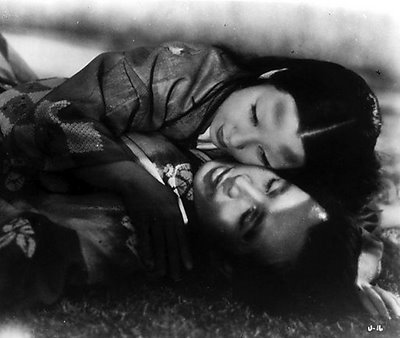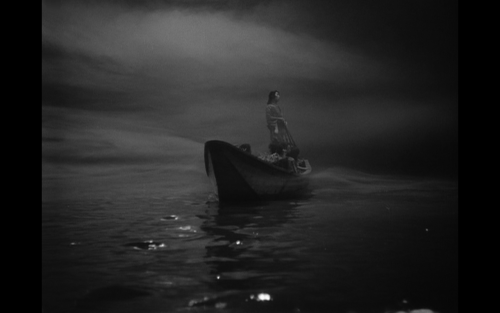Produced and Directed by Jacques Tati
Written by Jacques Tati, Jacques Lagrange and Jean L'Hote
Cinematography Jean Bourgonin
Editing Suzanne Baron
Starring Jacques Tati, Jean Pierre Zola, Adrienne Servantine, Alain Becourt
How do you study a film that is devoid of plot or detailed character analysis and yet is a classic?
Jacques Tati is perhaps the cinematic equivalent of Samuel Beckett, whose plays dispensed with the Aristotelian tradition of storytelling, which laid emphasis on plot and characterisation. Both Beckett and Tati dealt with the increasing isolation of the individual in the modern world.
As one of the major filmmakers during the post-war era, Tati, along with others like Antonioni, Bresson, Bergman and Godard, would be instrumental in changing the way films were read. His third feature film and his first in colour, Mon Oncle is essentially a tour-de-force of set pieces involving Mr. Hulot, Tati's trademark character, and his sister's son Gerard, who lives in an ultra-modern house and spends every evening after school with uncle Hulot. While Gerard and his mother are fond of Hulot, his father, an executive at a factory, is disdainful of him, largely due to his simplistic ways.
Hulot's sister tries every trick possible to get her brother into respectable society, like getting him a job at her husband's plant and finding a girlfriend for him, but they all simply fall flat. Hulot simply does not fit in "society proper"
Several of the film's set pieces revolve around the ultra-modern house Gerard and his parents stay in. It goes without saying that one of the prime concerns of the film is its lampooning of modernity. But that is not all there is to it. Tati also takes several digs at a society that prides itself on status and wealth.
Mon Oncle earns its praise mainly due to the way Tati gets his points across to the viewer. His use of colour to pit the old-fashioned world of Hulot to the modern, sterile world of his sister and her family, is simply extraordinary for its time. The dull greys of the modern settings, with the occasional intrusion of strong colours, is strongly contrasted with the warmer colours of Hulot's old-fashioned world.
Tati's disregard for convention can also be seen in his mise-en-scene. Close-ups and editing within a given scene are generally eschewed, opting to let the scene play out in distant, uninterrupted takes. He compensates for this relative rigidity in camera style by making extensive use of choreography, which makes the images a delight to watch.
Even more demonstrative of Tati's flouting of convention is his use of sound, and the soundtrack of Mon Oncle, as that of all of Tati's work, is one of the most meticulously designed in all of cinema. While there is little dialogue in the film, what dialogue there is is largely reduced to being just another sound effect. And yet the soundtrack adds so much to the spirit of the film that a great deal of the film's humour is lost if you switch off the sound, despite the fact that there is little dialogue in it.
There are several analogies that rise when mention is made about the Hulot character, mostly to the Tramp character of Chaplin. They are similar in that we see the same character in successive films (Unlike Keaton, who had different names in each of his films, but shared the same traits). Both characters are non-conformists who do not give a damn about the world. But while the Tramp is a yearning romantic, Hulot is not and does not care to be. His cool detachment is more like the Keaton type.
Tati's brand of film comedy clearly draws from the work of the great silent comics, and he is perhaps the last film artist to have taken their legacy forward. Sure is a pity that this legacy has not been taken forward.
Written by Jacques Tati, Jacques Lagrange and Jean L'Hote
Cinematography Jean Bourgonin
Editing Suzanne Baron
Starring Jacques Tati, Jean Pierre Zola, Adrienne Servantine, Alain Becourt
How do you study a film that is devoid of plot or detailed character analysis and yet is a classic?
Jacques Tati is perhaps the cinematic equivalent of Samuel Beckett, whose plays dispensed with the Aristotelian tradition of storytelling, which laid emphasis on plot and characterisation. Both Beckett and Tati dealt with the increasing isolation of the individual in the modern world.
As one of the major filmmakers during the post-war era, Tati, along with others like Antonioni, Bresson, Bergman and Godard, would be instrumental in changing the way films were read. His third feature film and his first in colour, Mon Oncle is essentially a tour-de-force of set pieces involving Mr. Hulot, Tati's trademark character, and his sister's son Gerard, who lives in an ultra-modern house and spends every evening after school with uncle Hulot. While Gerard and his mother are fond of Hulot, his father, an executive at a factory, is disdainful of him, largely due to his simplistic ways.
Hulot's sister tries every trick possible to get her brother into respectable society, like getting him a job at her husband's plant and finding a girlfriend for him, but they all simply fall flat. Hulot simply does not fit in "society proper"
Several of the film's set pieces revolve around the ultra-modern house Gerard and his parents stay in. It goes without saying that one of the prime concerns of the film is its lampooning of modernity. But that is not all there is to it. Tati also takes several digs at a society that prides itself on status and wealth.
Mon Oncle earns its praise mainly due to the way Tati gets his points across to the viewer. His use of colour to pit the old-fashioned world of Hulot to the modern, sterile world of his sister and her family, is simply extraordinary for its time. The dull greys of the modern settings, with the occasional intrusion of strong colours, is strongly contrasted with the warmer colours of Hulot's old-fashioned world.
Tati's disregard for convention can also be seen in his mise-en-scene. Close-ups and editing within a given scene are generally eschewed, opting to let the scene play out in distant, uninterrupted takes. He compensates for this relative rigidity in camera style by making extensive use of choreography, which makes the images a delight to watch.
Even more demonstrative of Tati's flouting of convention is his use of sound, and the soundtrack of Mon Oncle, as that of all of Tati's work, is one of the most meticulously designed in all of cinema. While there is little dialogue in the film, what dialogue there is is largely reduced to being just another sound effect. And yet the soundtrack adds so much to the spirit of the film that a great deal of the film's humour is lost if you switch off the sound, despite the fact that there is little dialogue in it.
There are several analogies that rise when mention is made about the Hulot character, mostly to the Tramp character of Chaplin. They are similar in that we see the same character in successive films (Unlike Keaton, who had different names in each of his films, but shared the same traits). Both characters are non-conformists who do not give a damn about the world. But while the Tramp is a yearning romantic, Hulot is not and does not care to be. His cool detachment is more like the Keaton type.
Tati's brand of film comedy clearly draws from the work of the great silent comics, and he is perhaps the last film artist to have taken their legacy forward. Sure is a pity that this legacy has not been taken forward.

.jpg)







